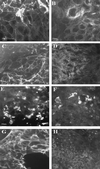Shiga toxin-producing Escherichia coli can impair T84 cell structure and function without inducing attaching/effacing lesions
- PMID: 10531251
- PMCID: PMC96977
- DOI: 10.1128/IAI.67.11.5938-5945.1999
Shiga toxin-producing Escherichia coli can impair T84 cell structure and function without inducing attaching/effacing lesions
Abstract
Enteropathogenic Escherichia coli (EPEC) intimately adhere to epithelial cells producing cytoskeletal rearrangement with typical attaching and effacing lesions and altered epithelial barrier and transport function. Since EPEC and Shiga toxin-producing E. coli (STEC) share similar genes in the "locus for enterocyte effacement" (LEE) thought to cause these changes, it has been assumed that STEC shares similar pathogenic mechanisms with EPEC. The aims of this study were to compare the effects of EPEC and STEC on bacterial-epithelial interactions and to examine changes in epithelial function. T84 monolayers were infected with STEC O157:H7 (wild strain EDL 933 or non-toxin-producing strain 85/170), EPEC (strain E2348/69), or HB101 (nonpathogenic) and studied at various times after infection. EPEC bound more avidly than EDL 933, but both strains exhibited greater binding than HB101. Attaching and effacing lesions and severe disruption to the actin cytoskeleton were observed in EPEC by 3 h postinfection but not in EDL 933 or HB101 at any time point. EPEC and EDL 933 increased monolayer permeability to [(3)H]mannitol 5- to 10-fold. In contrast to EPEC, EDL 933 completely abolished secretagogue-stimulated anion secretion as assessed under voltage clamp conditions in Ussing chambers. Several other STEC strains induced changes similar to those of EDL 933. In conclusion, STEC impairs epithelial barrier function and ion transport without causing major disruption to the actin cytoskeleton. Pathogenic factors other than products of LEE may be operant in STEC.
Figures





Similar articles
-
Characterization of the locus of enterocyte effacement (LEE) in different enteropathogenic Escherichia coli (EPEC) and Shiga-toxin producing Escherichia coli (STEC) serotypes.FEMS Microbiol Lett. 1998 Jul 1;164(1):133-9. doi: 10.1111/j.1574-6968.1998.tb13078.x. FEMS Microbiol Lett. 1998. PMID: 9675859
-
Shiga toxin-producing Escherichia coli strains from bovines: association of adhesion with carriage of eae and other genes.J Clin Microbiol. 1996 Dec;34(12):2980-4. doi: 10.1128/jcm.34.12.2980-2984.1996. J Clin Microbiol. 1996. PMID: 8940434 Free PMC article.
-
Serotypes, virulence genes, and intimin types of Shiga toxin-producing Escherichia coli (STEC) and enteropathogenic E. coli (EPEC) isolated from calves in São Paulo, Brazil.Int J Food Microbiol. 2007 Apr 20;115(3):297-306. doi: 10.1016/j.ijfoodmicro.2006.10.046. Epub 2007 Jan 12. Int J Food Microbiol. 2007. PMID: 17292501
-
The locus of enterocyte effacement pathogenicity island of Shiga toxin-producing Escherichia coli O157:H7 and other attaching and effacing E. coli.Jpn J Med Sci Biol. 1998;51 Suppl:S101-7. doi: 10.7883/yoken1952.51.supplement1_s101. Jpn J Med Sci Biol. 1998. PMID: 10211442 Review. No abstract available.
-
Toxins of Locus of Enterocyte Effacement-Negative Shiga Toxin-Producing Escherichia coli.Toxins (Basel). 2018 Jun 14;10(6):241. doi: 10.3390/toxins10060241. Toxins (Basel). 2018. PMID: 29903982 Free PMC article. Review.
Cited by
-
Potentiation of Antibiotics by a Novel Antimicrobial Peptide against Shiga Toxin Producing E. coli O157:H7.Sci Rep. 2020 Jun 22;10(1):10029. doi: 10.1038/s41598-020-66571-z. Sci Rep. 2020. PMID: 32572054 Free PMC article.
-
Do eicosanoids cause colonic dysfunction in experimental E coli O157:H7 (EHEC) infection?Gut. 2000 Jun;46(6):806-12. doi: 10.1136/gut.46.6.806. Gut. 2000. PMID: 10807892 Free PMC article.
-
In vitro adhesion properties of Shiga toxin-producing Escherichia coli isolated from cattle, food, and humans.Front Microbiol. 2015 Feb 27;6:156. doi: 10.3389/fmicb.2015.00156. eCollection 2015. Front Microbiol. 2015. PMID: 25774152 Free PMC article.
-
Polarization of specific tropomyosin isoforms in gastrointestinal epithelial cells and their impact on CFTR at the apical surface.Mol Biol Cell. 2003 Nov;14(11):4365-75. doi: 10.1091/mbc.e03-03-0169. Epub 2003 Sep 5. Mol Biol Cell. 2003. PMID: 12960432 Free PMC article.
-
Enterohemorrhagic Escherichia coli colonization of human colonic epithelium in vitro and ex vivo.Infect Immun. 2015 Mar;83(3):942-9. doi: 10.1128/IAI.02928-14. Epub 2014 Dec 22. Infect Immun. 2015. PMID: 25534942 Free PMC article.
References
-
- Bradbury N A, Jilling T, Berta B, Sorscher E J, Bridges R J, Kirk K L. Regulation of plasma membrane recycling by CFTR. Science. 1992;256:530–531. - PubMed
Publication types
MeSH terms
Substances
LinkOut - more resources
Full Text Sources

